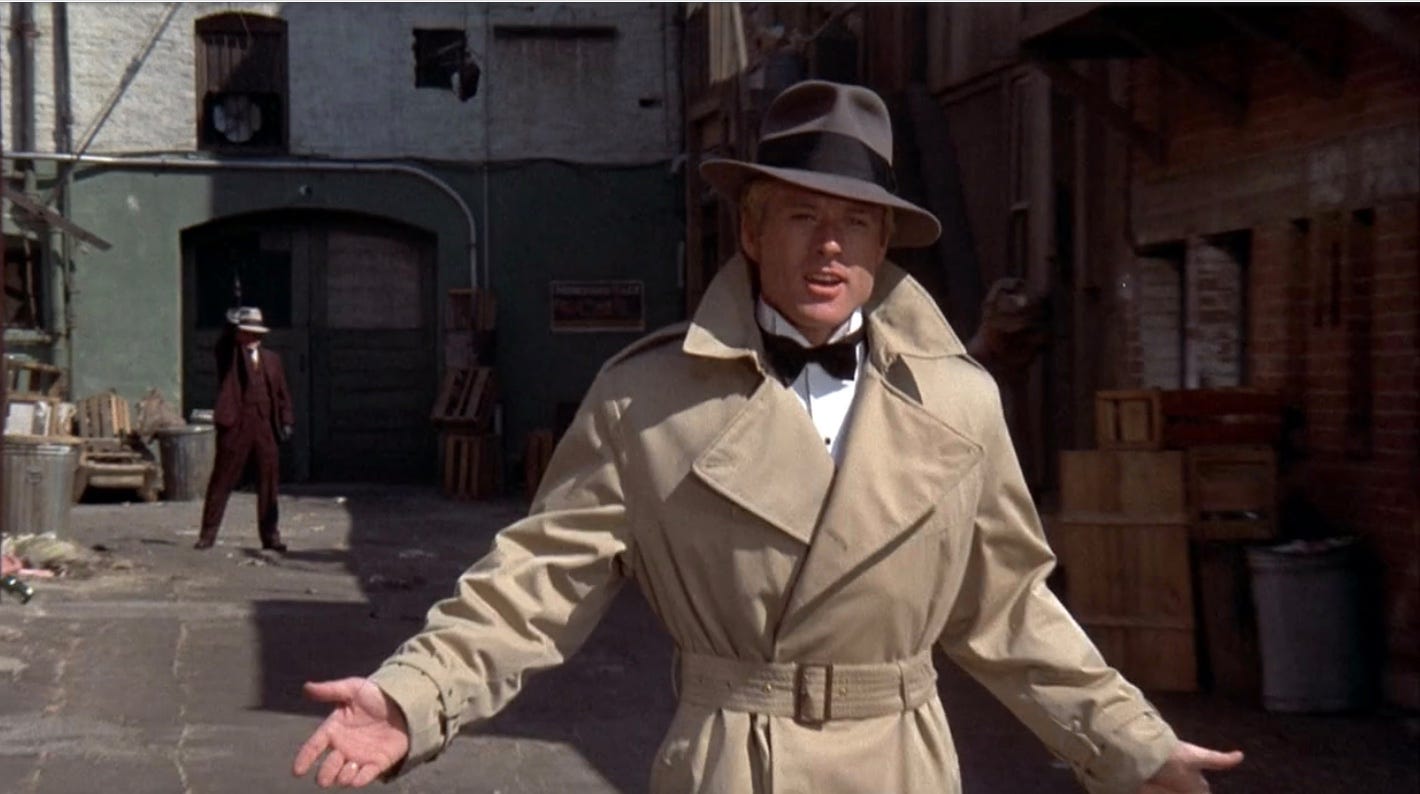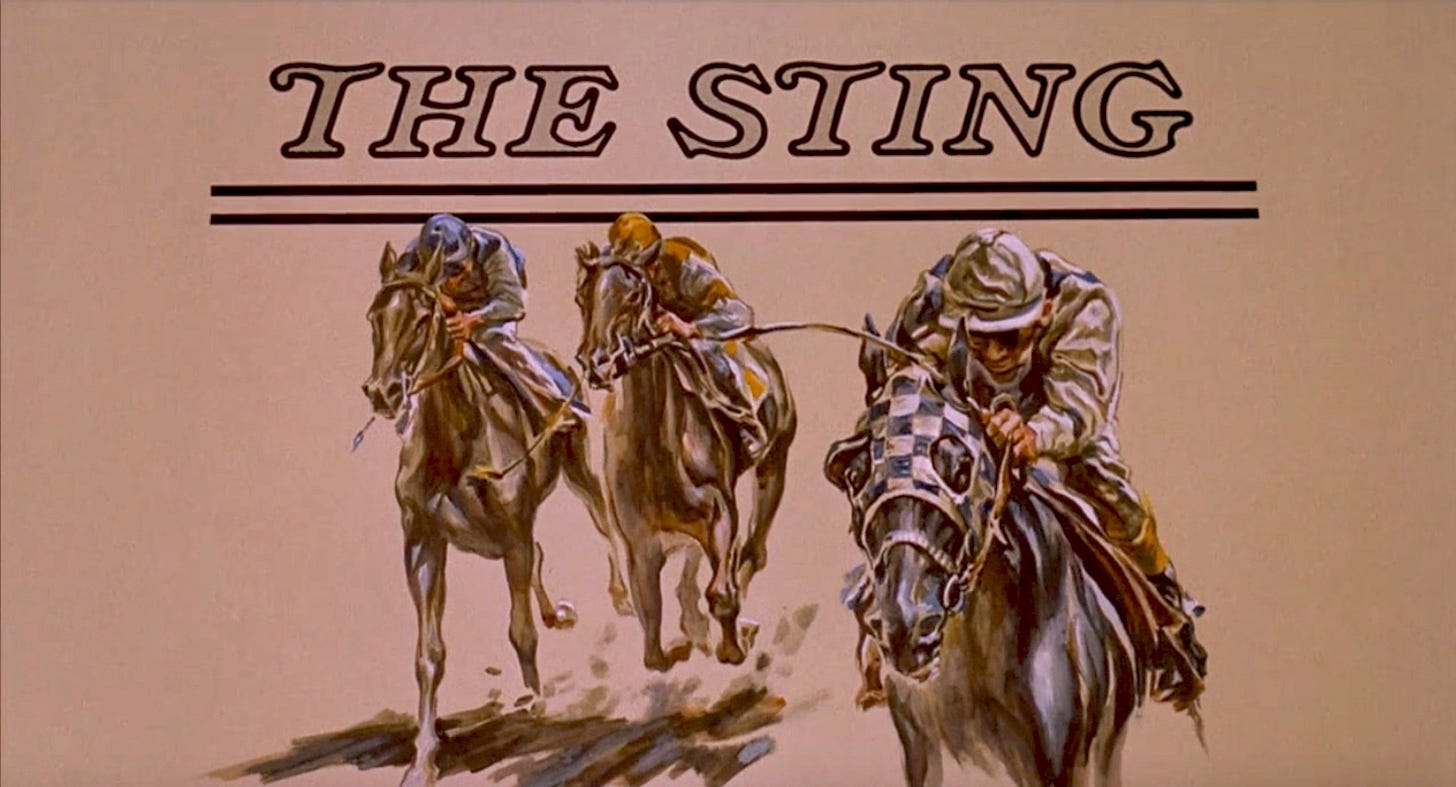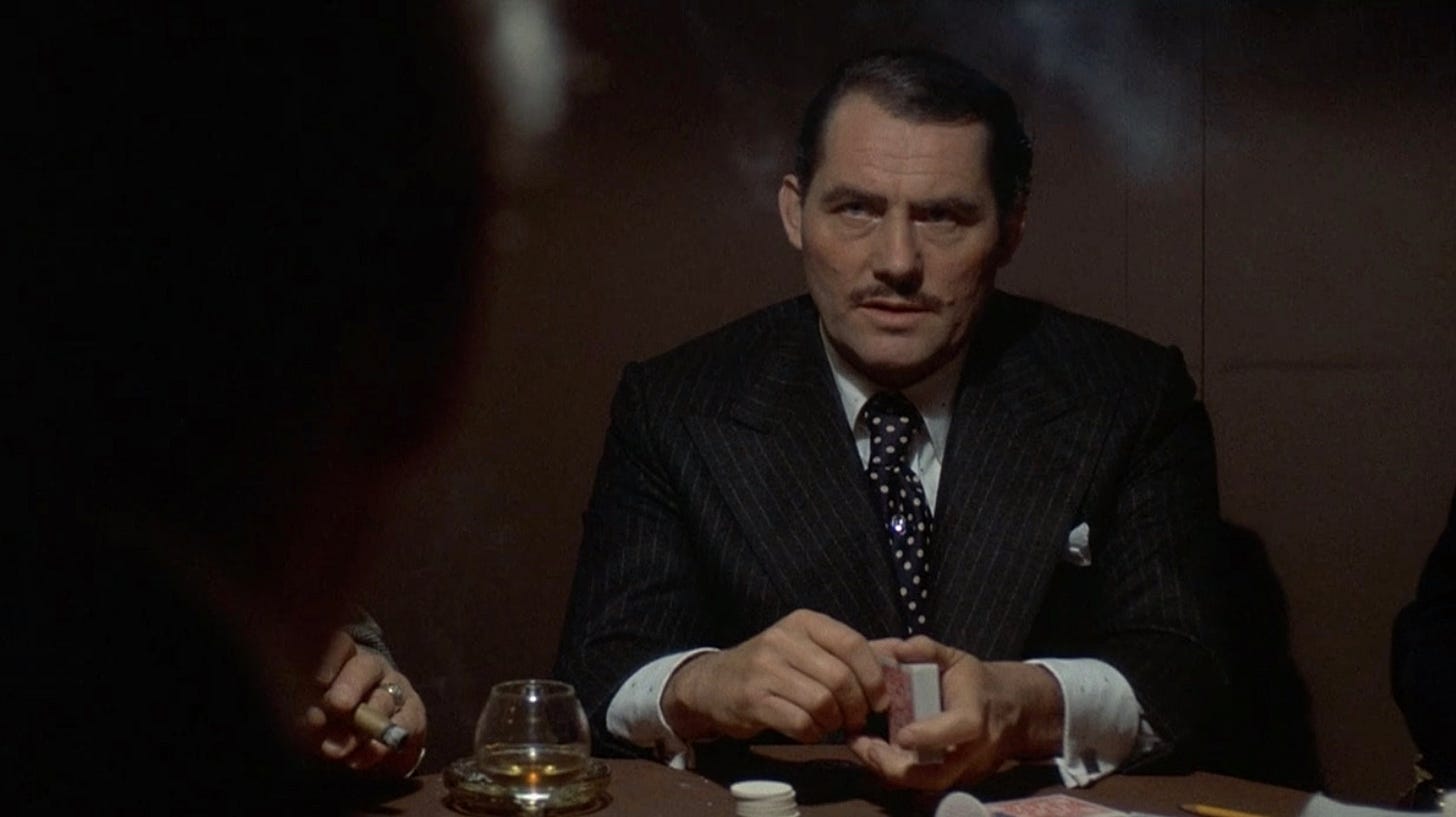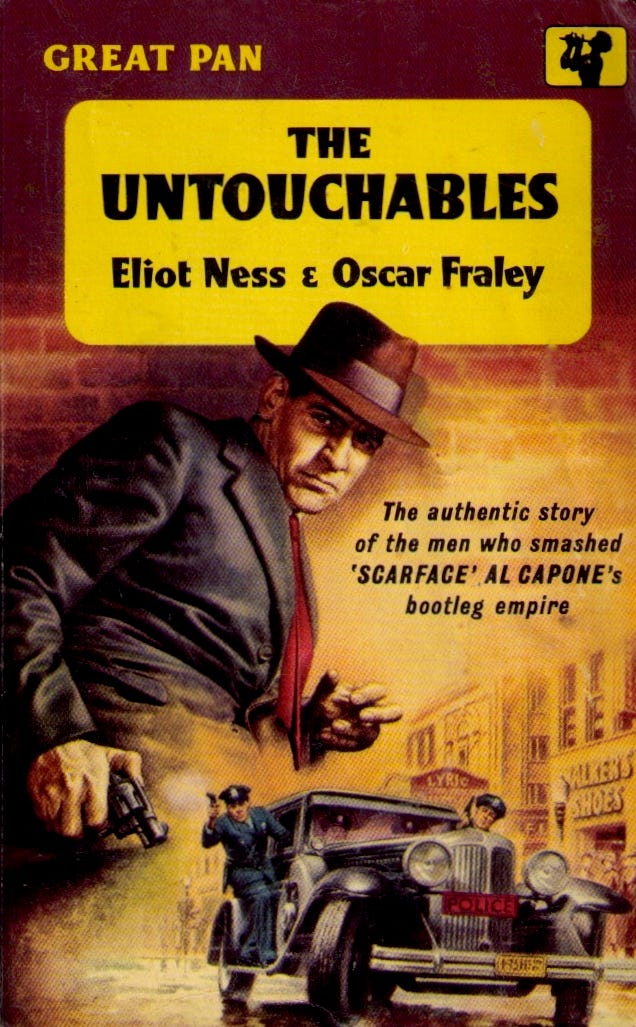The Sting (1973)
"She was gonna kill you, kid. Her name's Loretta Salino..."
“Take a good look at that face, Floyd. Because if he ever finds out I can be beat by one lousy grifter, I'll have to kill him and every other hood who wants to muscle in on my Chicago operation…”
In 1981, at sweet sixteen, I took a girlfriend to The Chicago Pizza Pie Factory. Found at no. 17, Hanover Square, in a dark corner opposite Vogue House, iron steps led down to a basement decorated in the speakeasy manner: neon lights, soda-fountain graphics, exposed brickwork, a cocktail bar, brash American waitresses, a television screen broadcasting recorded videos of American Football, and background chatter courtesy of Chicago’s WFYR radio. And you could pay in dollars; a genuine culture shock, especially when a waitress thrust a ghastly doggy bag in my hand and insisted, on pain of death, that we took the wretched thing away with us.
With hindsight, the look of the pie factory was very much a product of the 1970s. We might even call it ‘Gangster Chic’. For there’s a convincing theory that middle-aged admen become obsessed with the period just before they were born, which explains why the American Depression, Chicago Gangsters, Fedoras, Soda Fountains, Art Deco, Cloche Hats, Kipper Ties, Tiffany Lamps and Chicago Deep Pan Pizza spawned Bonnie & Clyde (1967), Biba, Ralph Lauren, The Sting (1973), Jack Clayton’s The Great Gatsby (1974), Strikes 1926, (a London hamburger chain decorated with sepia photographs of the unemployed), SodaStream and Bugsy Malone (1976); an appealing trend that began in the late 1960s, reached its zenith in the 1970s, and, as with the last gasp of the wonder that was Disco Deco, lingered on until the very early 1980s.
In 1972, for my father’s 40th birthday party, my mother bought a vast purple feather boa from Biba in High Street, Kensington — like a 1920s courtesan, although I doubt she saw it that way. And then some genius had the bright idea to repackage SodaStream (‘Get Busy with the Fizzy’) along the lines of a 1920s soda fountain: Coca-Cola-influenced graphics and little glass bottles with impressed swirls, to which the kiddywinks might add brightly coloured cordials, and which, ignoring the goody-goody instructions, you could fizz up by pressing a little button two hundred times — like Gatsby’s butler and the machine that extracted the juice of two hundred oranges in half an hour.
Which takes us to The Sting (1973). It’s a beautifully made film, like a bespoke suit, framed with inter-title cards, ‘reminiscent of the golden glow of old Saturday Evening Post illustrations’, a film which has so many good things to say about it, especially on account of Robert L. Surtees’ cinematography and Henry Bumstead’s fabulous and beautiful set design. 1936 Chicago is recreated on the Universal Studios backlot in all its glory: iron fire escapes, corner drugstore soda fountains, telephones, typewriters, and ticker tape, neon-lit alleyways and trash cans, all filmed in muted browns and maroons under lighting deliberately designed to ape the 1930s. Steam belches from sidewalk grills, and cars swish by with a languid purr; on The Chicago Limited, there’s a distant clang of bells as the express train speeds through the level crossings, the echoed clack of metalled co-respondents as mobsters run down a secluded alleyway.
In one of my favourite scenes, period cars traverse a flyover, set against a painted backdrop of the Chicago skyline, punctuated by skyscrapers, an Art Deco fantasia, like something from Metropolis (1927). The finished effect is truly aesthetic, reminding me of the backdrops in Éric Rohmer’s The Lady and the Duke (2001), a film set during the French Revolution, in the manner of late 18th-century engravings. And we can most certainly add The Sting to our growing list of aesthetes’ films, for The Sting is an intensely visual film, a quality, of course, which passed me by when I first saw it with my grandfather at the Beaconsfield Odeon in the summer holiday of 1974.
I suppose The Sting might be considered a sequel (of sorts) to Butch Cassidy and the Sundance Kid (1969). Both films were directed by George Roy Hill and star Paul Newman (Henry Gondorff) and Robert Redford (Johnny Hooker). In The Sting, the buddies are fictitious Chicago conmen, as opposed to historical outlaws. Universal Pictures then faced a plagiarism suit when David Maurer claimed that ‘the screenplay was based too heavily on his book, The Big Con (1940), about real-life tricksters, Fred and Charley Gondorff.’ Of course, the buddy-buddy, male double-act thing was very much a trend of the 1970s: Curtis and Moore in ITC’s The Persuaders (1971-2), Alias Smith & Jones (1971-3), Starsky & Hutch (1975-9), and Britain’s answer to the Los Angeles Police Department, The Professionals (1977-1983).
Robert Shaw steals the show as limping mobster boss Doyle Lonnegan, like an Irish Al Capone. Shaw’s especially good in the hard-as-nails, tough guy roles: the bogus Captain Nash in From Russia with Love (1963); the weathered sea-dog, Romer Treece, in The Deep (1977), and the syphilis-ridden Lord Randolph Churchill in Richard Attenborough’s Young Winston (1972) — an outstanding performance. Doyle Lonnegan! It’s all there. The double-breasted pinstripe suits, the black-and-white polka dot ties, the immaculate tie-pin, those awful motifed shirts, the camel-hair coat — all this later parodied beautifully by the Dandy Dan character in Bugsy Malone (1976):
“This is the big one. The shakedown. The payoff. It’s got to be good. Got to be neat. Got to be quick… You shouldn't have any trouble. Just Sam and a few dance hall girls… Remember when you get inside that speakeasy, keep those fingers pumping because it'll be history you'll be writing…”
This is the world of The Untouchables, of grifters, gangsters and showgirls, although, actually, it’s worth pointing out that The Sting is set in 1936, three years after the end of Prohibition. But Hard times. Everyone’s down on their luck. Everyone’s broke. Everyone’s a chancer. Everyone’s on the make; America’s precarious tip culture: a day-to-day, hand-to-mouth, tough guy existence. Go on a job, earn two hundred bucks and get your tailor to run up a suit. Simonizing a Cadillac: The American Dream.
And to finish off, we have to discuss the music. Scott Joplin's world-famous soundtrack includes The Entertainer, the musical sensation of the 1970s, and Solace- A Mexican Serenade, perhaps Joplin's most beautiful piece. During the 1970s, and because of The Sting, the music of Scott Joplin, the 'King of Ragtime', enjoyed a deserved revival. Interestingly, Nonesuch Records released Joshua Rifkin's album, Scott Joplin: Piano Rags, in 1970, three years before The Sting — although undoubtedly the film helped the album to achieve an impressive one million sales. Joplin's music, as a result of the film, became associated, in the public imagination, with the 1920s and 1930s, despite the obvious anachronism. For Ragtime was very much a product of the late 19th century and the very early years of the 20th century. The Entertainer dates from 1902, and Solace- A Mexican Serenade from 1909. Scott Joplin, in my opinion, was a genius. In 1916, he died of syphilitic dementia and was buried in an unmarked pauper's grave. He was only forty-eight years old.
I watched The Sting (1973) on Amazon Prime Video digital download, altho’ from memory I have a DVD languishing upstairs, somewhere in our hovel. And, of course, The Sting is also available to watch on Blu-ray.
Before I go, a quick word about the paid subscription, which costs £5 a month or £50 a year. Paid subscribers get their own special post on Friday mornings, extra bonus posts on High Days and Holidays, and access to the entire archive — which is now running at some 132 films. Sunday morning’s post is free, and can be read by everybody and anybody. I hope you enjoy The Sting (1973) as much as I did. Bourbon for this one. Has to be. Until Friday…










Shaw’s turn as Henry VIII in A Man For All Seasons is superb too. Probably the best screen Henry, although of course Laughton remains iconic
The Sting is the first film I ever saw in a theater. When it was re-released to theaters in 1977, my mother (who had gone to see it at least half a dozen times during its original release) took me along to see it with her.